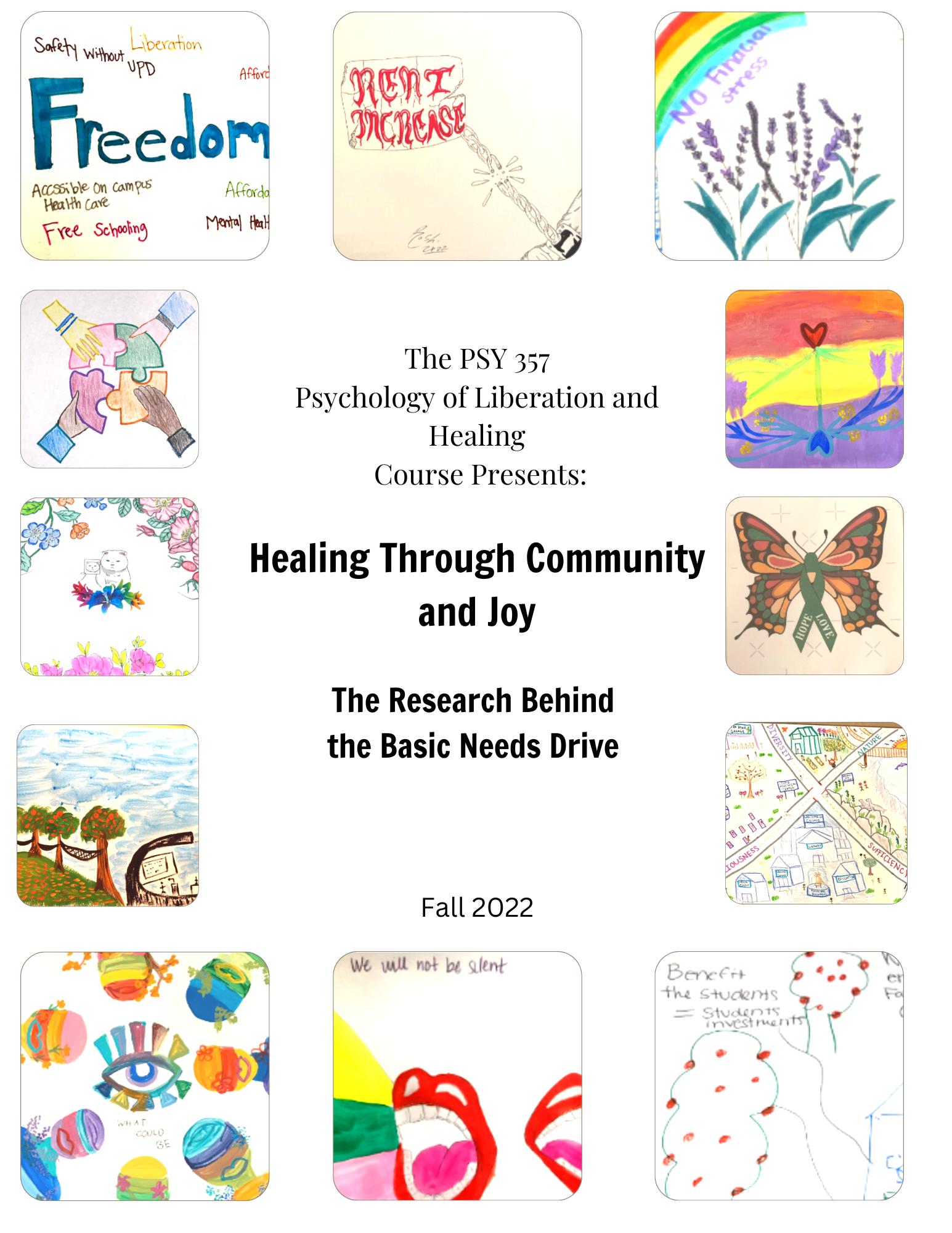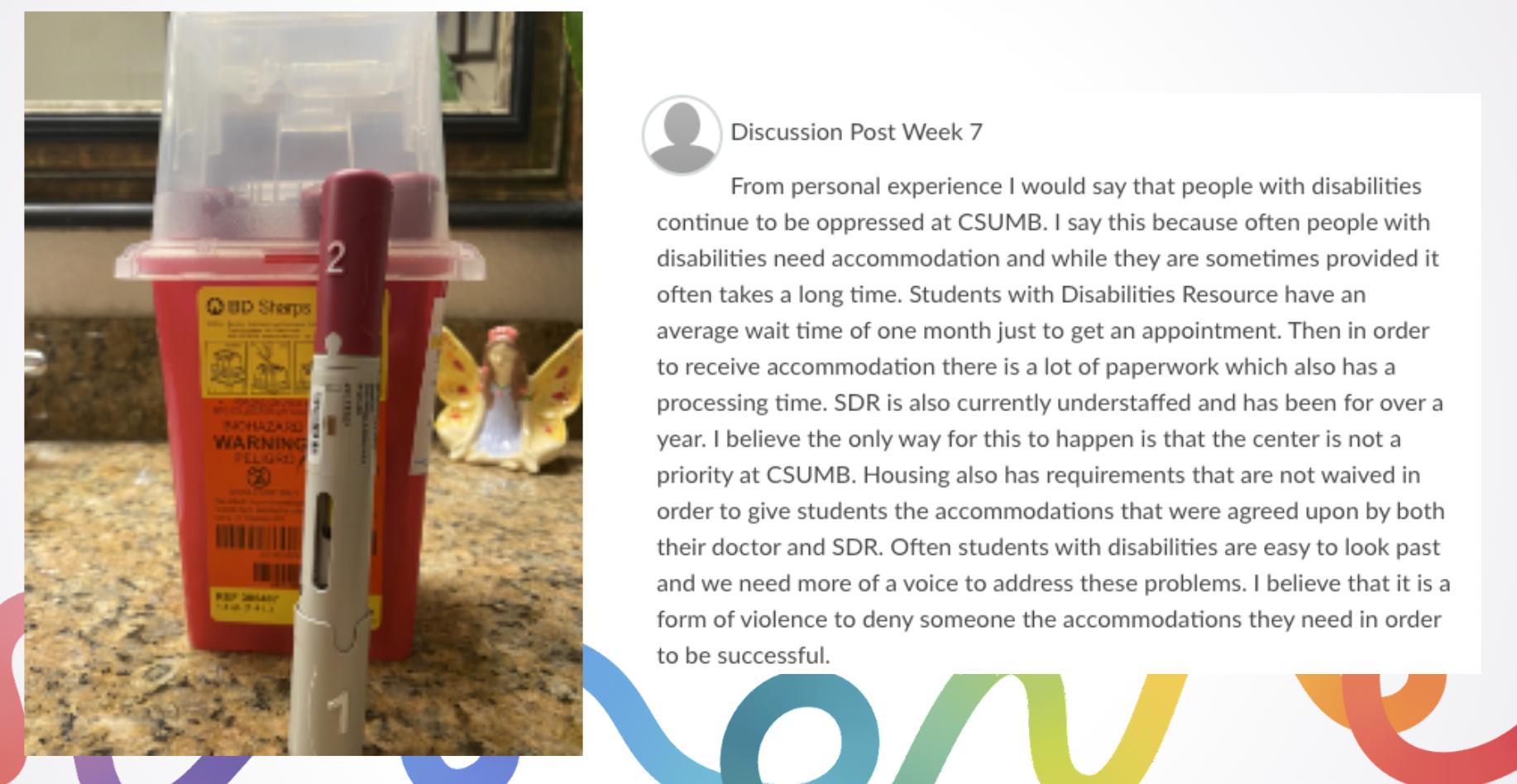

INTRODUCTIONFROMTHECOURSEINSTRUCTOR
“Radical healing is resisting oppression and moving toward freedom ” ShawnGinwright,PhD
Welcome!Ifyouarereadingthiszine,youmayhaveattendedtheactionthattookplaceonDecember8, 2022atCSUMB The“HealingthroughCommunityandJoyBasicNeedsDrive”Thepurposeofthis zineistoprovidebackgroundandcontextofthisactionandwhyitwascollectivelydecided.Itisalsoto sharetheresultsofthestudyandinformstudentsaboutsomeoftheservicesavailableoncampus
Theco authorsofthiszinearestudentsinPSY357PsychologyofLiberationandHealing.Thecourseis brandnewthissemesterandisapsychologycourse,anethnicstudiescourse,aswellasaUROCCourse UndergraduateResearchExperienceCourse(CURE).ThepurposeofaCUREcourseistoprovide undergraduatestudentswithhands onresearchexperience.
WhatisLiberationPsychology?
Given that this is a Liberation Psychology course, the research that was developed in this course was rooted in this framework One of its pioneers was Spanish Social PsychologistIgnacioMartín Barówho carried out his work in El Salvador (Montero & Sonn, 2009). Observing the limitations of mainstream psychology, Martín Baró wasinterestedindevelopingapsychologythatwouldhelptransformoppressive systems and structures through praxis using research informed theory and putting that theory into practice to create social change. Martín Baró carried out much of his work via opinion polls distributed among the most marginalized and impoverished members of Salvadoran society (Martín Baró, 1994)
Through his opinion polls, Martín Baró was able to challenge government narratives, or their “Official Lies.” For using his research in this transgressive way, Martín Baró,alongwithfourotherJesuitpriests, the Rector of the Universidad Centroamericana (UCA), the housekeeper and her daughter were all assassinatedbyU.S.trainedSalvadorantroopsin1989(Martín Baró,1994).
This course, Psychology of Liberation and Healing, is designed to keep with liberation psychology scholars’ tradition of speaking truth to power and of using praxis to create change as well as promote healingbyresistingoppressionandbuildingtheworldwewanttosee Thebasicneedsdriveisourpraxis, ourwayofusingourresearchacquiredknowledgetofomentchange.
HowWeConductedOurResearch
Following anti oppressive research principles (Strega & Brown, 2015), and to minimize potential harm, the students in the entire class participated as both co researchers and participants in this study Functioning as one 30 person research lab, the students in the course were first given a Photovoice prompt: “What forms of oppression are silenced at CSUMB?” In alignment with the photovoicemethod (Sutton Brown, 2014), eachstudentpainted,drew,and/orcollectedimagestorespondtothisquestionand provided a 150 200 word narrative description to explaintheimages Asaclasswecollectivelyanalyzed these images and narratives during class and identified three patterns, one of which was “the lack of affordableorfreebasicneeds,”whichcontributedtostudentsnotfeelingsafeoncampus
Following this qualitative analysis, the students were asked what they wanted to know more about to understand this issue Collectively, the class refined and decided on the following research question,
“What basic needs issues are students facing and what are students' perception of these needs being met/not met?” Students voted to answerthisresearchquestionthroughdevelopinganopinionpoll/survey using Google Forms Borrowing some questions from UC Campus Climatesurveysaskingaboutcollege food and housing insecurity,studentseditedthesurvey,anddevelopedtheirownquestionsandresponses. Students felt it was importanttoaskquestionsaboutstudents'experienceswithvariousofficesoncampus including the Basic Needs Office, CSUMB Police, the Housing office, the Personal Growth and Counseling office (PGCC), and the Student Disability Resource Office (SDR). After the survey was completed, students anonymously filled it out As a class, we spent time discussing the results of the survey using descriptive statistics and studying the pie charts generated by Google Forms Students workedinsmallergroupstofocustheirstudyonstudents'experiencesforoneoftheoffices.
StudyResults
One of the most extreme results noted was the disparity between students' knowledge of the location of various resource offices in contrast to the CSUMB police office Out of all the resource offices we examined, the CSUMB police is the most known office, even as it is located at the outskirtsofthemain campus When factoring in students' experiences with police, 839% of students have indicated that the police have either “never” (326%) or only “rarely” (516%) met their needs of feeling safe on campus Yet, only less than a quarter (21%) of students know where the basic needs office is located and is the resourcestudentswanttoseemoreof Theotherresultsofthisstudyareavailablethroughoutthiszine
PlanforAction
After reviewing and summarizing the results we asked, “what is to be done? How do we planttheseeds for liberation knowing what we know now?” Students also did another photovoice in response to the question, “what could be at CSUMB? What are your desires for healing and liberation?” (you can see some of these photovoice images on the front cover of this zine) Combining theresultsofthestudyand these visions for liberation, students shared ideas for a basic needs drive and as a class we decided to pursue this option We were intentionalabouthostingthiseventoutsideinfrontoftheBasicNeedsoffice building and collaborating with the Basic Needs office for this event to bring greater visibility The students also wanted to create this zine to share the results of this study and inform their fellow peers abouttheservicesoncampusandwhattheyoffer
This basic needs drive is shaped around thepraxisofmutualaid,acommunitystrategyforprovidingone another what we need when our systems and institutions have failed to provide for us This zine was created before the event with collective visions of wanting to provide a space for community,tosupport one another, to feel good, to be out in nature, to provide opportunity/accessibility, and to demand accountability We hope that in some ways we accomplished these visions and that thisexperiencehelps ustolearnhowwecandobetterasaCSUMBcommunity.
ChristineRosales,PhD(courseinstructor)
References
Martín Baró(1994) Writings for a liberation psychology.HarvardUniversityPress. Montero,M.&Sonn,C.(2009).Aboutliberationandpsychology:Anintroduction.InM.Montero&C.Sonn (Eds), Psychology of liberation: Theory and applications (pp 1 10) SpringerPublishing Strega,S.&Brown,L.(2015). Research as resistance: Revisiting critical, indigenous, and anti oppressive approaches (2nded) CanadianScholars’Press Sutton Brown,C.A.(2014).Photovoice:Amethodologicalguide. Photography and Culture, 7(2),169 185.
TABLEOFCONTENTS
MutualAidBasicNeedsEventFlyer p 4
Howto:AccessYourBasicNeeds
ByVanessaCruspero,AshmeetaPrasad,AllisonBaker, JanetteAlcala
HowtoApplyforBasicNeeds@CSUMB
ByVanessaCruspero,AshmeetaPrasad,AllisonBaker, JanetteAlcala
ImpactofBasicNeedsResults,PhotovoiceofBasicNeeds, andWhatBasicNeedsOffers
ByJalesaArmen,KaitlynWilyard,AutumnHorton,Megan Johnson,CharisyMathis
p 5
p 6
…………………………………………..pp.7 9
BasicNeedsResults
ByAshleyTikayOntiveros,ChelseaCoronado,SerenaRoss pp 10 11
HomeSweetHome:ImpactsofHousingInsecurityStudentHousing
ByAmberKing,EmilyShim,LuisVirgen,KevinNguyen, MoniqueGomez
WhatisthePGCC?
BySaraIbarra,AlexxiaPreciado,BrennaThomas,andLiza Gonikberg
SDRStudentDisabilityResourcesStudyResults
ByEmilyFederspiel,DeniseGonzalez,GinaGrady,Maria Martinez
PhotovoiceonDisabilityandAccessibility
CuratedbyEmilyFederspiel,DeniseGonzalez,GinaGrady, MariaMartinez
StudentDisabilityResources
ByEmilyFederspiel,DeniseGonzalez,GinaGrady,Maria Martinez
ResultsonPolicing
ByYocelynJimenezGarcia,JamieLanza,TylerSimmons,S.D. Strang-Dado,JillGiambattista
PhotovoiceonPolicing
CuratedbyYocelynJimenezGarcia,JamieLanza,TylerSimmons, S.D.Strang-Dado,JillGiambattista
pp 12 14
………………………………………..pp.15 16
p 17
p 18
……………………………………………..p.19
…………………………….……...…..pp.20 21
p 22
QuoteonCapitalismbyAlexisPaulineGumbs ImagedesignedbyVanessaCruspero p 23
QuoteonChangefrom Parable of the Sower ImageDesignedbyVanessaCruspero p 24
ClassPhoto …………………………………….….p.25



Results Found In Our Research: The Impact of Basic Needs on College Students
From The Question on The Poll: “I feel the campus adequately communicates services related to the Basic Needs office”
● 43.8% of the respondents selected “Not applicable to me/have not sought these services'' this is less than half of the students to the above question.
● This may address the issue of students still needing the services; however, the campus not clearly informing students of the available resources could prevent students from actively seeking the Basic Needs Office.
● Which may result in an abundant amount of “ non applicable” responses.


● Students may feel their basic needs are not being met due to the lack of communication on campus.
● In response to the question “I feel the campus adequately communicates services related to the Basic Needs office” more than a quarter (37.5 %) of students in some form felt that the campus is not providing students with the resources available for basic needs
● This could suggest that students are unaware of the services provided by CSUMB and they may be unable to obtain them even if needed.
Below Are Some Narratives From the Photovoice Activity Used In Our Research to Portray Students Not Having Their Basic Needs Met:




Services Offered From Basic Needs:

Common Questions About What The Basic Needs Office Offers:
1. What are Basic Needs?

● “The CSUMB Basic Needs Initiative endeavors to support students to be successful by ensuring their basic needs are met through resources, access and advocacy.” (CSUMB Website) ● A service provided by the school to help students access resources that could help resolve issues around basic needs (i e financial insecurity, food insecurity , etc )

2. What services does the Basic Need O�ce O�er?
3. How Do We Access
The Basic
Needs Emergency
Fund?
● The emergency fund is awarded through the Basic Needs Initiative
enrolled as a CSUMB student
In need of urgent financial need with supporting documentation


have exhausted all sources of financial aid
Students are only eligible for these funds once per semester
Results:

A survey was conducted of a total of 32 students to see how many students were aware of the services o�ered at CSUMB and what needs were being met



● Some of the major results that we discovered was the lack of information that the school provides about the basic needs o�ce
○ Out of 32 students, about 80% of students stated that they didn't know where the Basic Needs o�ce was located

● 25% of the students stated that they financial issues that interfered with their groceries

○ About 32% of the students stated not eating because of their financial issues
■ Of these students, it was equally divided by 33% between 3 di�erent options in which they chose how many months they’ve done this
Contact Basic Needs Office:
Phone: 831 582 4081


Email: basicneeds@csumb.edu
Instagram: @csumb.basicneeds
Basic Needs Office Location: Building 12 (Student Center)

To reach the Food Pantry, as you walk to building 12, go to the left side wing of the building and access through the second door from left and the double doors to your left, which is the entrance. If you enter through automatic sliding doors, you take a left, go to the end of hall, take another left, go to end of hall and it is the last double doors to your right. (map shown below)



HOME SWEET HOME: The Impact of Housing Insecurity at CSUMB
Students in Psychology of Liberation and Healing in fall 2022, 84.4% of students did not have an understanding of all the specifice housing services provided by CSUMB

On CSUMB website housing section and under resources states the following
● YOU HAVE THE RIGHT to a safe and secure living environment
● YOU HAVE THE RIGHT to the assistance of a Resident Advisor, Community Director, Associate Director, or other Student Housing & Residential Life sta� members when you need help with a problem
● YOU HAVE THE RESPONSIBILITY to notify a sta� person of your problem and request assistance in a timely manner and to cooperate with those involved as they work with you as you solve your problem
28 1% of students in Psychology of Liberation and Healing are not confident or satisfied on how student housing is adequately communicating with their needs

Student Housing Resources:


CSUMB Student Housing (831)582 3378 csumb.edu/housing Student housing@csumb.edu
Contact from 8 a.m. 8 p.m. phone and email Student center building 12



SDR- Student Disability Resources Study Results
Based on our research, we found that:
Students are lacking the knowledge and understanding regarding all the specific services provided by the SDR office.
- We noted that about 84.4% of students responded that they do not feel they have an adequate understanding of all the services provided by the SDR center.
- Only 15.7% of students feel that their need for disability accommodations at CSUMB are taken seriously.

Photovoice on Disability and Accessibility

and we need more of a voice to address these problems. I believe that it is a form of violence to deny someone the accommodations they need in order to be successful.” CSUMB student


ResultsonPolicing
Inthisstudyourgroupfocusedonthe policingresultsofthesurveyandlookedat themalongsideourdemographicdata responses.Inourgrouppodweidentifiedthreemajorresults:studentsareworried aboutthemselvesandtheirfriendsbeingharassedbypoliceoncampus,students reportedthatpolice“rarely”or“never”mettheirneedsoffeelingsafeoncampus, andstudentsarenotgivenenough informationregardingcampuspoliceservices.
















